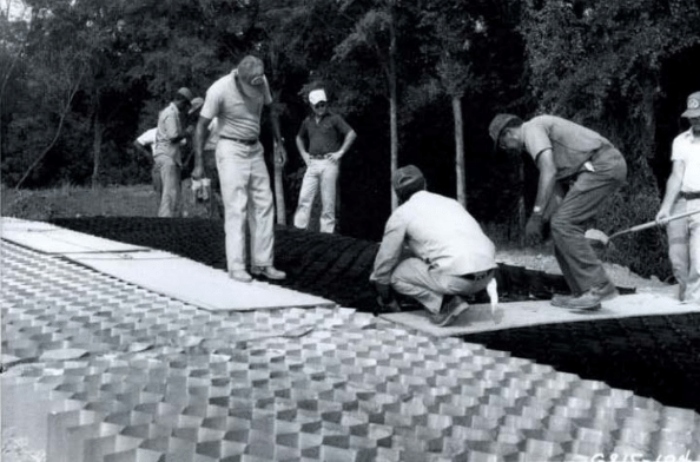By Ashley Beyer, Content and Marketing Specialist, Presto Geosystems
Presto Geosystems, which invented geocells in the late 1970s, expands on the history of geocells technology.

Geocell technology has come a long way over the past four decades. In its early days of development, the geocellular soil confinement system consisted of wax-coated craft paper; a plastic drainage pipe matrix fastened with staples; paper-thin, hexagon-shaped, glued aluminum; low- and medium-density recycled materials; pure polyethylene without UV stabilization; and square cells similar to old-fashioned egg carton separators.
The invention of geocell technology
In the late 1970s, the U.S. Army Corps of Engineers (USACE) contacted Presto Products Co.—a private-label consumer packaging manufacturer—to develop a more robust honeycomb-shaped confinement system that would maintain load-bearing strength under heavy vehicle loads.
Working with Steve Webster at the Waterways Experiment Station (WES), Presto’s Gary Bach devised a method to weld polyethylene strips to form a cellular structure. This innovative system became known as Sandgrid and was used by the military primarily for road applications.
After the development of Sandgrid, Presto created a new business unit, Presto Geosystems, to focus solely on the geosynthetics business.
Presto Geosystems and the USACE tested various resin blends and concluded that virgin high-density polyethylene (HDPE) provided superior weld consistency and structural strength. Presto Geosystems introduced the GEOWEB Cellular Confinement System (CCS) to the geosynthetics market in the early 1980s.
In the years following the initial testing, geocell technology continued to advance, paving the way for the use of geocells in new civil and military applications. In addition to a load-support solution, the GEOWEB system provided soil stabilization for the rapid construction of fortified walls in Kuwait and Iraq during Operation Desert Shield (1990–91) and Operation Desert Storm (1991).
The GEOWEB system’s big-screen debut
The GEOWEB system made its Hollywood debut in the 1994 sci-fi action-adventure movie, Stargate. To serve as the desert landscape in the film, filmmakers chose the barren setting surrounding Yuma, Ariz. However, very loose sands at the film location made transportation around the site virtually impossible. Crews used the GEOWEB system to create an “instant road,” using on-site sand as infill that allowed vehicles and heavy equipment to move around the desert with no rutting or loss of traction.
“We never would have been able to move around the desert without [GEOWEB].”
Roland Emmerich, director, Stargate
Fast-forward to today’s GEOWEB geocells
The GEOWEB system did not let fame go to its head, but these early applications and projects did help cement its stardom in the world of geosynthetics. Since its introduction in the 1980s, the GEOWEB Soil Stabilization System has been used on every continent and on thousands of load support, slope stabilization, channel protection and retaining wall projects.
 TEXTILES.ORG
TEXTILES.ORG


